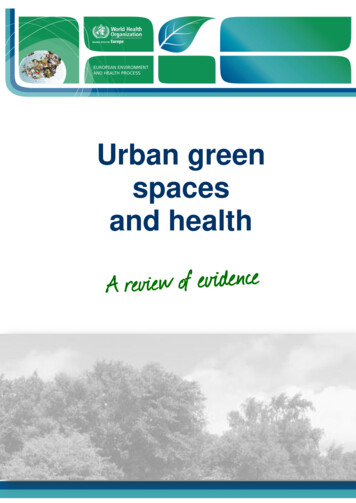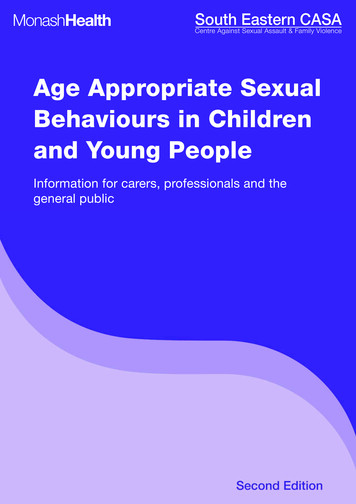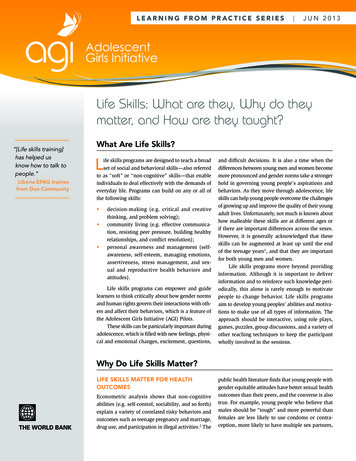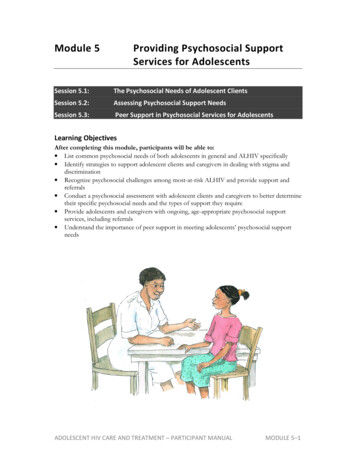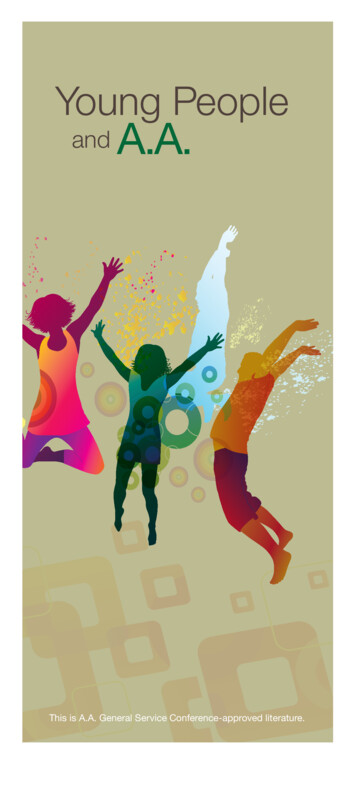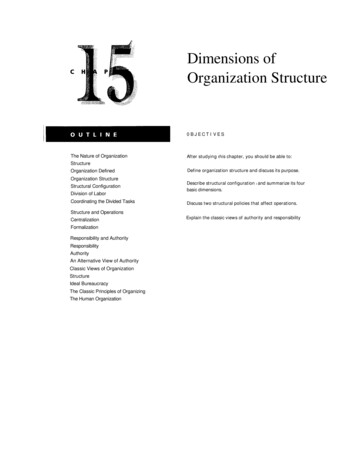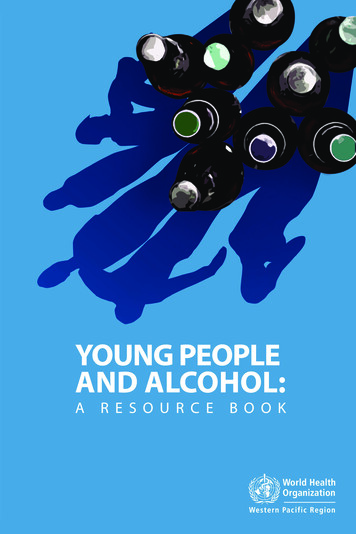
Transcription
YOUNG PEOPLEAND ALCOHOL:A RESOURCE BOOK
WHO Library Cataloguing-in-Publication DataYoung people and alcohol: a resource book1. Adolescent behaviour. 2. Alcohol drinking. 3. Alcoholism – in adolescence.4. Alcohol-related disorders. I. World Health Organization Regional Office for the WesternPacific.ISBN 978 92 9061 684 9(NLM Classification: WM 274) World Health Organization 2015All rights reserved. Publications of the World Health Organization are available on the WHOwebsite (www.who.int) or can be purchased from WHO Press, World Health Organization, 20Avenue Appia, 1211 Geneva 27, Switzerland (tel.: 41 22 791 3264; fax: 41 22 791 4857;email: bookorders@who.int).Requests for permission to reproduce or translate WHO publications—whether for sale orfor non-commercial distribution—should be addressed to WHO Press through the WHOwebsite (www.who.int/about/licensing/copyright form/en/index.html). For WHO WesternPacific Regional Publications, request for permission to reproduce should be addressed toPublications Office, World Health Organization, Regional Office for the Western Pacific, P.O.Box 2932, 1000, Manila, Philippines (fax: 632 521 1036, email: publications@wpro.who.int).The designations employed and the presentation of the material in this publication do notimply the expression of any opinion whatsoever on the part of the World Health Organizationconcerning the legal status of any country, territory, city or area or of its authorities, orconcerning the delimitation of its frontiers or boundaries. Dotted lines on maps representapproximate border lines for which there may not yet be full agreement.The mention of specific companies or of certain manufacturers’ products does not implythat they are endorsed or recommended by the World Health Organization in preference toothers of a similar nature that are not mentioned. Errors and omissions excepted, the namesof proprietary products are distinguished by initial capital letters.All reasonable precautions have been taken by the World Health Organization to verifythe information contained in this publication. However, the published material is beingdistributed without warranty of any kind, either expressed or implied. The responsibility forthe interpretation and use of the material lies with the reader. In no event shall the WorldHealth Organization be liable for damages arising from its use.
CONTENTSPreface . ivAcknowledgements . vAbbreviations . viExecutive summary . vii1. Introduction . 12. Biological and psychological aspects of drinking by young people . 33. Alcohol use among young people in the Western Pacific Region:patterns and trends .194. Consumption and alcohol-related harm among young people:contributing factors and prevention measures . 43References . 63
PREFACEThis publication is meant for anyone who has an interest in the healthand welfare of young people in the Western Pacific Region of the WorldHealth Organization (WHO). It compiles what is known about the effects ofalcohol consumption on young people, the current situation in the Regionregarding drinking among young people and what can be done to limitthe resulting harm.Over the last few decades, great advances have been made in the sciencestudying the effects of alcohol consumption on health and what canbe done to reduce these effects, which are far greater than previouslyassumed. WHO has therefore accorded high priority to reducing alcoholrelated harm in all parts of the world.It has also become increasingly clear that the consumption of alcoholby young people deserves special attention, as biological, neurological,social and psychological factors make them much more vulnerable tothe negative effects of alcohol. The Western Pacific Region has, generally,a very young population, and overall alcohol consumption is increasingrapidly. Given the growing threat to young people’s health and welfareby alcohol consumption in the Region, the WHO Regional Office forthe Western Pacific is promoting effective action on this subject, thuscontributing to healthy youth in the Region.iv
ACKNOWLEDGEMENTSThis resource book was commissioned by the Mental Health andSubstance Abuse (MHS) unit of the WHO Regional Office for theWestern Pacific.The manuscript was developed by Yvonne Bonomo (The University ofMelbourne, Melbourne, Australia), Cornelius Goos (MHS Consultant,Vienna, Austria), John Howard (University of New South Wales, Sydney,Australia), Taisia Huckle (Massey University, Auckland, New Zealand) andNina Rehn Mendoza (Nordic Centre for Welfare and Social Issues,Helsinki, Finland).The authors wish to thank for the peer reviews and comments provided,by Marie-Françoise Brugiroux (French Polynesia Alcohol and DrugAddiction Treatment and Rehabilitation Centre, Papeete, FrenchPolynesia); Sally Casswell (Massey University, Auckland, New Zealand),Regina Ching (Department of Health, Hong Kong Special AdministrativeRegion) David Jernigan (Center on Alcohol Marketing and Youth,Baltimore, Maryland, United States of America), Kwang Kee Kim(Inje University, Seoul, Republic of Korea), Vladimir B Pozynyak (WHO,Geneva, Switzerland), Dag Rekve (WHO, Geneva, Switzerland) andReinout Wiers (University of Amsterdam, Amsterdam, the Netherlands).v
WHOvi––––––––––Alcohol Use Disorders Identification TestGlobal School-Based Student Health Surveyminimum unit pricePacific island countries and territoriesSurvey Assessment of Vietnamese YouthSpecial Administrative RegionSecond Generation HIV SurveillanceJoint United Nations Programme on HIV and AIDSYouth Risk Behavior SurveyWorld Health Organization
EXECUTIVE SUMMARYThe understanding of alcohol and related harm has advanced significantlyin the past few decades, bringing more insight into associated publichealth policies. The Regional strategy to reduce alcohol-related harm,endorsed in 2006 for the Western Pacific Region of the World HealthOrganization, and the Global strategy to reduce harmful use of alcohol,endorsed in 2010, recognize the serious impact of alcohol-related harm,which is particularly relevant to young people due to their biological andpsychological vulnerability.Alcohol is the world’s fifth leading risk factor for disease burden. In theWestern Pacific, 5.9% of all deaths are attributable to harmful use ofalcohol – one person dies for alcohol-related harm every minute. Harmfulconsumption of alcohol has many negative consequences—it not onlyleads to many neuropsychiatric disorders and noncommunicable diseasesbut is also associated with several communicable diseases. Especiallyamong children and young people, it is further linked to injuries.Adolescence is a key time of behaviour change in an individual’s life cycleand for brain reorganization. Alcohol consumption during this periodadversely affects these developmental changes. Further, young peoplehave particular reactions to alcohol as compared to adults; while they areless sensitive to sedation and mobility effects, they are more sensitive to itssocial and rewarding effects. These reactions can make young people easilyintoxicated, placing them—and the community—at risk of physical, sexualand emotional harm. Furthermore, young people can develop dependenceon alcohol more quickly than adults, and persons who initiate drinking atearly ages tend to develop alcohol problems later in life.Today many more young people are drinking and at younger ages. Inthe Region, 15–30% of young people drink. While the gender gap inprevalence is generally closing, rural–urban differences remain in somecountries and areas, with more drinkers in urban areas. Binge drinkingis also becoming more and more common. Young people are reportingincreasing alcohol-related harm and risks including injuries, risky sexualactivity, suicidality and impaired relationships and participation ineducation and employment.Key factors including the availability of alcohol, the price of alcohol andalcohol marketing—easier access, cheaper prices and exposure to an ever-vii
increasing variety and intensity of marketing efforts—contribute to heavierconsumption and related harm. However, they can be effectively curbedby restricting youth access to alcoholic beverages through establishingand enforcing minimal drinking legal age limits, outlet density and tradinghours and by increasing alcohol prices through taxation policies. In theinterest of young people’s health, alcohol marketing can and should bebanned or restricted by legislation.Besides legislative measures, additional interventions such as communityaction, brief interventions and treatment can prevent or reduce alcoholconsumption by at-risk populations. Drink–driving countermeasures,including “zero tolerance” and random breath testing, are effective inreducing alcohol-involved road crashes, saving the lives of countless youngpeople. Involving young people themselves is an important element indeveloping and implementing appropriate policies and programmes.viii
1. INTRODUCTIONUntil the late 20th century, the focus of health systems and societies wason alcoholism as a disease and its treatment, but it is now widely acceptedthat this represents a too-narrow view of the broader scope of problemsassociated with alcohol consumption. The health and social problemslinked with alcohol affect many more people than just the alcoholics orproblem drinkers (1). For example, alcohol consumption has been shownto have complex links with poverty (2). Further, much of the resulting harmhas nothing to do with alcoholism but is the result of actually drinkingalcohol, drinking too much or drinking at the wrong moment.Harmful drinking is a major determinant for a number of neuropsychiatricdisorders and other noncommunicable diseases, such as cardiovascularand liver disease and many cancers (3). A causal relationship existsbetween harmful use of alcohol and incidence of several infectiousdiseases, such as tuberculosis and the progression of HIV/AIDS. Inaddition, risky sexual behaviour while intoxicated increases the risk ofunplanned pregnancies and sexually transmitted infections. Road trafficand other injuries, associated with alcohol use, are a major cause ofsignificant mortality and morbidity among children and young people,as are violence and suicide. In fact, alcohol is the world’s fifth-largest riskfactor for disease burden, and it is responsible for 5.9% of all deaths in theWestern Pacific Region (4). This translates to one death every minute dueto alcohol-related harm in the Western Pacific.There is now a substantial body of knowledge and policy guidance onthe impact of alcohol consumption on public health. In the wake of thisgrowing insight, much research has been conducted on opportunitiesfor controlling the risks associated with alcohol consumption. There isnow abundant evidence on the effectiveness of many different strategiesand programmes (5). Although most of the research is from developedcountries, much of the work applies to other countries and areas aroundthe globe.The World Health Organization (WHO) has accorded high priority to theimpact of alcohol consumption on public health. The WHO RegionalCommittee for the Western Pacific endorsed, in 2006, the Regionalstrategy to reduce alcohol-related harm (6), and at the World HealthAssembly in May 2010, Member States reached a consensus on the Globalstrategy to reduce harmful use of alcohol (7). In addition, many studies1
and publications have been produced following up on these decisions.1Recently, with the support of the Government of Hong Kong SpecialAdministrative Region (SAR), the WHO Regional Office for the WesternPacific organized the Regional Meeting on NCD Disease Prevention andControl through the Reduction of Alcohol-Related Harm from 10 to 13April 2012, and the Regional Meeting on Addressing the Harmful Use ofAlcohol by Young People from 12 to 14 November 2013 (8, 9). In theseand many related documents, particular relevance is attributed to youngpeople—rightly so, as the effects of alcohol intake on the still-developingbody and mind of young people are, in many respects, more serious thanthe effects it has on adults.Most societies, including those in the Region, traditionally have strictnorms and standards that prohibit or severely restrict the use of alcoholby young people. However, these norms and standards, together withthose that regulate behaviour, are gradually fading. Thus, drinking isoccurring more frequently, and beginning at younger ages (10). As theWestern Pacific Region has a very young population, it is therefore logicalto focus on this segment of the population. Accordingly, several countriesand areas within the Region have already identified young people2 as aparticularly important group in the development of their alcohol policies.In the following chapters, the biological and psychosocial aspects ofdrinking alcohol by young people, the extent of drinking and relatedproblems among young people, contributing and causative factors ofharmful drinking among young people and the opportunities for reducingalcohol-related harm among young people are reviewed.1 Accessible on the WHO website (http://www.who.int/substance abuse/publications/en/).2 WHO defines young people as people aged 10–24 years.2
2. BIOLOGICAL ANDPSYCHOLOGICAL ASPECTSOF DRINKING BY YOUNGPEOPLESummary points: Adolescence is a key time of behaviour change in an individual’s life cycle and typically the time that alcohol consumptioncommences.Adolescence is also a key time for brain reorganization. Rapidchanges occur in circuits involved in social and emotionalbehaviour, and more gradual changes occur in circuits involved inthinking ahead, planning and decision-making. Alcohol impactson these developmental changes.While cognitive processes play an important role in young people’sdrinking, automatically activated impulsive behaviour appears tobe especially important in adolescents with alcohol problems.Young people are less sensitive to some side-effects of alcohol(e.g. sedation, impaired mobility) but more sensitive to its socialand rewarding effects. This means they can readily reach highlevels of intoxication.Intoxication in young people puts the young person at risk ofphysical, sexual and emotional harm and puts the community atrisk as a result of disinhibited behaviour.Psychosocial risk is closely associated with problem alcohol use.Genetic risk is also an increasingly recognized factor in problemdrinking.Physical harm caused by alcohol includes liver injury, manyforms of cancer, gastrointestinal damage, immunodeficiency,cardiovascular disease, abdominal obesity and neurological harm.Early onset of alcohol consumption is a predictor of alcoholproblems in adulthood.The onset of dependence on alcohol occurs more quickly in youngpeople than in adults.3
Interventions to reduce heavy alcohol consumption and alcohol-related problems can be broad-based (e.g. focusing on factors in ayoung person’s environment) or can be targeted to those at higherrisk (e.g. focusing on psychological or biological factors).2.1 What is known about adolescent development?Youth, or adolescence, is a stage in an individual’s life during which thetransition from childhood to adulthood occurs. It is characterized byphysical, cognitive and psychosocial change. WHO defines young people asaged 10–24 years (11).Adolescent development is not just chronological age or the physicalphenomenon of puberty. Adolescence includes developmental tasks, whichare achieved in stages as the young brain develops and matures. This isimportant to keep in mind when dealing with young people, as it influencesboth the way one communicates with them and what one can expect ofthem. The stages of adolescent development are summarized in Table 1.Table 1: Summary of stages of development in young peopleSTAGEKEY FEATURESDETAILSEarly 11–13 yearsPhysiologicalchanges ofpuberty Concrete thought Physiological changes of puberty Increase in social and emotional responses withonset of pubertyMiddle 14–15 yearsPeers andidentity Abstract thought Striving to define identity: experimental behaviour,risk-taking, sense of omnipotence and invincibilitythat may sometimes place the individual atsignificant danger (e.g. high-risk drinking) Sexual identity emerges, dating increases butrelationships typically tend to be self-centred inqualityLate 16–20 yearsPlanning forfuture More mature intellectual capabilities Sense of their own identity becomes evident Peers and family relationships remain but one-onone relationships become importantYoungadulthood 21–25 yearsand beyondEstablishingandconsolidatingadult roles Continuing education or employment Financial considerations and independence more apriority Longer-term view of relationships and partnershipsSource: Reproduced by permission of the publisher from Saunders & Rey (12).4
YOUNG PEOPLE AND ALCOHOL: A RESOURCE BOOKIt is important to note that within a given individual, cognitive, physicaland psychosocial maturation may not necessarily be in sync. Also, youngpeople’s development does not progress at the same rate in all individuals.Some young people are capable of mature thinking and decision-makingat an earlier age, depending on various factors such as gender, socialinteraction and cultural context.Some other caveats may apply to adolescent development as sketchedhereabove. First, the developmental tasks as described in Table 1 tend torepresent the situation in the societies where independence is perceivedas an important part of upgrowing, while in some countries and areas inthe Western Pacific Region interdependence is seen as more important.Second, there are specific cultural aspects in some countries and areas thattranslate into milestones of development that differ from some of thoselisted in Table 1 (e.g. in many communities in the Region, young peoplemay need to work full-time to assist their families). Likewise in societieswhere marriages are arranged by the families and where this may occur inearly or middle adolescence, the psychosocial developmental trajectorywill be different.The young brain undergoes significant structural and functional changethrough adolescence and young adulthood (for more details, see [13–15]).Brain connections are refined, with some being removed (known as“pruning”), and others being strengthened to enable improved efficiencyand effectiveness of transmission of neural signals. It is also known thatthe brain maturation process occurs earlier in some parts of the brainbut later in such areas as the prefrontal cortex, which plays an importantrole in executive functions (i.e. the ability to determine the consequencesof actions, suppress urges, discern between conflicting thoughts andconcepts and good and bad).Executive functions are still relatively immature during the teenage years.Typically, young adolescents (i.e. ages 12–14 years) do not consistentlythink logically and can frequently underestimate risk. Instead, pubertalhormones at this time activate the social and emotional areas ofthe developing brain, driving young people’s behaviour during thisdevelopmental period (16, 17). By mid-adolescence, young peopleare becoming more experienced and are increasingly able to thinkabout things in more mature ways. As a result, they become better atrecognizing the impact of drinking on their health and well-being and onthose of others.5
It should be noted, however, that young people in mid-adolescence canstill frequently be inconsistent in their thoughts and behaviour. Wideranging experimentation and challenging of boundaries with concomitantrisk typically flourish at this time. This includes associating with new friendgroups, developing different interests and seeking novel experiences (e.g.sexual, drug-related, sensation-seeking). Such developmental behaviourmay become problematic in young people, and whether it persistsdepends on an individual’s predisposition and social circumstances.However, unquestionably, these important aspects of adolescentbehaviour need to be recognized when developing policies and strategiesto reduce alcohol-related harm in young people.2.2 Why do young people drink?Motives to drink in young people have been studied extensively(18, 19) and are similar those in adults. Understanding the motives todrink provides insight into the likelihood of drinking, its pattern and itsconsequences. Thus, interventions to reduce alcohol-related harm canbe developed based on this information. Motives to drink have beencategorized into four groups and are described in Table 2.Table 2: Motives to drink in young peopleMOTIVEEnhancementDESCRIPTIONTo enhance positive mood orwell-beingEXAMPLE Drinking for “the kick”SocialTo obtain social rewards Drinking to affiliate with othersCopingTo lessen negative emotions Drinking to manage negativemoodConformityTo avoid social rejection Drinking to reduce or avoid socialproblemsSource: (20)2.3 What are the psychosocial risk factors for alcohol problems in youngpeople?There is no single risk factor that can be attributed to a young person’salcohol use or alcohol-related problems, but a psychosocial risk factor andprotective factor framework can be used to understand an individual’slikelihood of progressing to problems with alcohol. Alcohol problemscorrelate with psychosocial risk, which is a function of the balancebetween risk factors and protective factors. The framework takes into6
YOUNG PEOPLE AND ALCOHOL: A RESOURCE BOOKaccount not only the characteristics of the individual but also the factorsin that individual’s environment that contribute to the trajectory he or shemay follow.Resilience is often referenced in this framework, denoting the ability to bewell-adjusted and interpersonally effective despite experiencing adversity(21). Factors that counter risk factors and help people deal positively withlife changes are referred to as protective factors, which may be events,circumstances or life experiences. Connections to family, school, interestgroups or spirituality have been identified as important protective factors.Risk and protective factors may vary over time and have differing impactsat differing points or stages of development (22).The framework is relevant to interventions at both an individual and acommunity level and to policy formation, as approaches to managingalcohol use in young people aim to reduce risk factors and strengthenprotective factors where possible. Figures 1 and 2 demonstrate typicalcausal pathways in an effort to show how multiple factors at key points inlife interconnect. It can be seen in this model how events can cumulativelylead towards reduced capacity to respond to adverse social outcomes(Figure 1). Alternatively, protective factors can work towards resilience andpositive outcomes (Figure 2).7
Figure 1: Understanding the casual pathways3Crime andviolenceAbsence ofemployment &meaningful roleAvailabilityof harmfuldrugsAffiliation withdeviant peersNon-supportiveschool environment(exposure tobullying/racism)Adverseparenting &exposure toviolenceGeneticfactorsSuicidalbehaviourHarmful drug &alcohol useLow self-esteemSchool &learningdifficultiesSelf-regulation ofemotion, attention &social ltiesPeerproblemsAcute stress /significant lossNegative thinkingpatternsPoor problemsolving skillsEarly neurological (brain)developmentinteractionLow SES, maternalinfections, drug use &exposure to neurotoxinsDiet &nutritionTimeSource: Reproduced by permission of the copyright holder of this figure from Department of Indigenous Affairs, Governmentof Western Australia (22).3 This figure was originally produced by the Telethon Kids Institute.8
YOUNG PEOPLE AND ALCOHOL: A RESOURCE BOOKFigure 2: Pathways to Resilience4Personal achievement, social competenceand emotional resilienceOpportunities for achievement andrecognition of accomplishmentsResponsive parenting (i.e.appropriate care stimulationand monitoring)GeneticfactorsOptimal braindevelopmentin uteroand earlychildhoodHealthypregnancy,reduced maternalsmoking, alcohol& drug misuseSense ofSense of socialself-efficacy connectedness& self-worthAcademic success &other achievementsHealth beliefs andclear standardsPositiveinteractionwith peersReducedexposure toharmful drugsEffective learning,communication &problem-solving skillsPositiveinteractionwith adultsEffective self-regulationof emotion, attention &social interactionAvailability of positiveadult role models andengaging communityactivitiesSocial and economic environments supportive to child rearing—especiallyabsence of poverty and exposure to violenceHealthy nutrition in utero and throughout childhood and adolescenceTimeSource: Reproduced by permission of the copyright holder of this figure from Department of Indigenous Affairs, Governmentof Western Australia (22).2.4 Why can alcohol use be excessive among young people?The psychosocial risk factors that can contribute to excessive alcohol useamong young people can be broadly categorized into (1) environmental;and (2) individual.Environmental factors relate to society, community and family. Theyinclude favourable messages about alcohol in mass media, such as thosein social media; ready availability of alcohol, such as the clustering ofalcohol outlets; parental modelling of drinking; and peer influences. Whilethe initiation of alcohol use by young people may be associated withmodelling, curiosity or wanting to “fit in”, maintenance and escalation of4 This figure was originally produced by the Telethon Kids Institute.9
use have much to do with the perceived rewards—personal or social—that the young person links with the use of alcohol.While environmental influences appear to be important factors in theearly teenage years, genetic factors increasingly influence heavy drinkingin the later teenage years into young adulthood (13, 14, 23). Detailedevidence for the role of genetics on heavy drinking in young people issteadily growing, and it is clear that there are multiple inherited influenceson alcohol use. For instance, young people with a family history of alcoholproblems have reduced sensitivity to alcohol (i.e. feel less intoxicated athigh blood alcohol levels than others). Some individuals are geneticallypredisposed to react at lower doses of alcohol, with facial flushing andfeeling generally uncomfortable; this reaction has been attributed toinactive dehydrogenase enzymes in the metabolism of alcohol, estimatedto be present in approximately 40% of those of Asian descent.The interplay between genetic susceptibility and environment iscomplex but important, as demonstrated by the suggestion that geneticpredisposition can even influence selection of environmental factors(e.g. antisocial peers) that are associated with alcohol problems (23). Inshort, environment can play an important mitigating, or alternativelyaugmenting, role in the expression of genetic risk for alcohol problems.Age of onset of drinkingEarly onset of drinking (before age 16 years) is strongly associated with thedevelopment of alcohol use disorders (15). Both genes and environmentare thought to influence the transition to alcohol consumption. A processof “kindling” may, in part, explain the link between early onset of drinkingand greater risk of problem drinking—cycles of regular exposure toalcohol early in brain development result in neurophysiological changesthat drive further, escalating consumption of alcohol.Pattern of drinkingA pattern of drinking is strongly associated with both short-term andlong-term alcohol problems. Binge consumption, usually defined as morethan five standard drinks on a single occasion of drinking, tends to be aprominent association with short-term consequences, while frequencyof consumption has been linked to the development of longer-termproblems. Binge drinking leads to a high blood level of alcohol, and thisimpacts the normal cerebral processes of inhibition and self-control,10
YOUNG PEOPLE AND ALCOHOL: A RESOURCE BOOKleading to a heightened risk of accidents, aggression or unsafe sexualbehaviour. Frequent consumption of alcohol induces both acute andchronic tolerance in young people (24), and this is thought to prime thebrain for perpetuating heavy, and therefore problematic, alcohol use.Psychological processes in alcohol useDrinking motives. Certain motives have been linked to heavier drinkingand to alcohol-related problems. Drinking for social reasons is the mostcommon motive for alcohol consumption for both young people andadults, but does not appear to predict alcohol problems. On the otherhand, drinking to enhance positive mood and drinking to cope arerelated to overall heavier alcohol use, but it is the coping motive that hasparticularly been related to alcohol problems (18). Individuals who drinkto cope frequently report that they tend to drink alone, and it has beennoted that their reliance on alcohol can lead to a further deterioration inthe ability to cope (24).Alcohol expectancies. Anticipated outcomes of alcohol consumption,known as expectancies, influence drinking
Alcohol by Young People from 12 to 14 November 2013 (8, 9). In these and many related documents, particular relevance is attributed to young people—rightly so, as the effects of alcohol intake on the still-developing body and mind of young people are, in many


